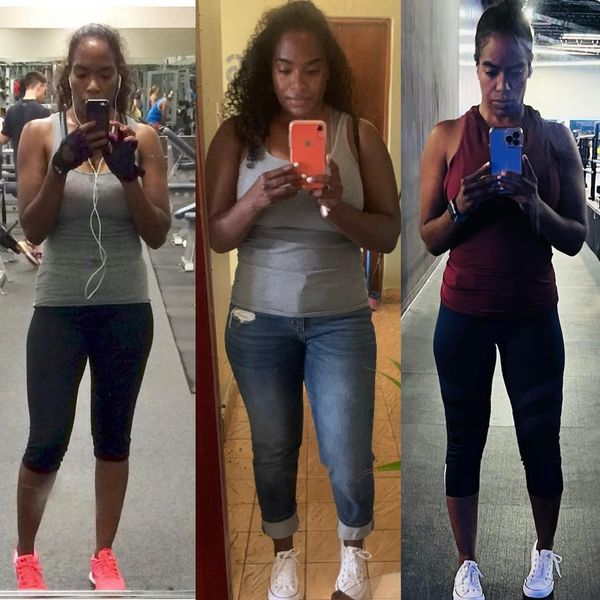
The Origin Of Blaming Women For The Sins Of Men
Pop culture moments in the making are always something to watch, but no one could’ve prepared themselves for what was in store for this year’s Academy Awards. In fact, I hate to bring it back up because it was so annoyingly over-discussed. Still, I’m bringing this to the table again, and ironically, because it doesn’t sit with me how quickly people used this as further proof of Jada Pinkett Smith ruining Will Smith. But, I’m calling bull! It’s one thing to turn on Will (though I don’t agree due to the murky history the Oscars have of uplifting actual predators), but to turn on Jada?
Well, that’s further evidence of my belief that this world is out to get women, especially those who stray from social norms in any shape or form. However, our society has a long-standing history of holding women accountable for the sins or wrongdoing of men.
Time and time again, history has demonstrated that women are expected to not only be pure, holier than thou beings but that when men go astray it is because the woman in his life was a stray arrow. I first learned of this concept in regards to sexuality, but it’s clear like many other aspects of life, that it has a trickle-down impact. Twitter critics came out in droves to crucify Jada because it was speculated that she gave Will a look signaling him to defend her honor, then again because of previous clips of her speaking on their relationship dynamic.
People used this as an opportunity to support their previous arguments that Jada was toxic because she as a woman should’ve willed Will to sit his ass down. They used inaccurate clickbait to have the public believe she had actually spoken against her husband, when in fact, all quotes have been from previous dialogues. While I would love to make this a Black woman issue, this is a woman issue!
This does not negate the fact that this phenomenon may take different shapes when experienced by Black women or be more complicated to navigate. In conversation with xoNecole, Psycho-Historian Shannon Hannaway notes how “blame has historically been shifted to Black women even in instances where the power dynamic in no way reflects the verbiage – even in modern times it is used to describe the events of the past.”
She further highlights Thomas Jefferson and his abusive relationship with Sally Hemings, which has never actually been stated that way in history books. To Hannaways’s point Hemmings, who was a Black slave, is often described as the dead president's “mistress” rather than “a survivor of sexual assault and abuse.”
While purity culture started out as a concept relegated to WASP (White Anglo-Saxon Protestants), I believe respectability politics played a role in Black women attempting to maintain these social constructs no matter how impossible it was due to the controlling images that continued to make a mockery of Black women’s attempts to successfully integrate amongst white women in this way (and many others).
Hannaway says, “Purity culture is very much so a WASP concept, although there are variations throughout the history of this idea, the version we know today in the United States is a direct result of the Cult of Domesticity – a movement that began between 1820 and 1860. To be pure and good was a status symbol for wealthy white women, absolute virtue was a sign of this status and women’s role in keeping the home, raising children, and acting in accordance with purity and goodness.”
“Traditional” womhanood is a farce. Because the femininity script folk speak of when they talk about feminity is a farce created to elevate white women. The purity, piety, domesticity and submissiveness. It is a script.
— Ava Anointing (@SoualiganAmazon) July 25, 2020
However, she pinpoints the tipping point and significant difference as it pertains to the racial piece of our intersectional identities being that “...at this same time slavery was still legal, and even after the Civil War, Black women experienced a shift from formal slavery to near-slavery in the homes of wealthy white women and in fact did a majority of home-keeping behind closed doors.”
Hannaway goes on to add, “White women were afforded the privilege to act in accordance with the Cult of Domesticity, whereas Black women and their families were expected and in fact still considered less than despite the end of slavery. Black women did not have the privilege of spending time with their own families, and [were] blamed for their inability to shift careers and be present in their families. Historically Black people have been treated in accordance with white colonial belief systems that commodify bodies and remove personhood, shifting moral righteousness to white people.”
This circles back to my initial point of Black women being held and expected to maintain the same standards as white women, as they are the pinnacle of purity and exemplify the behaviors that we Black women ought to mimic – yet constantly finding our best imitation to be unacceptable merely because of our Brown hues and the status attached to it.
Hannaway continues, “In the world we live in, men and women are socialized in a way that removes the blame from men and places a disproportionate amount of responsibility on women starting at an early age. Research reflects that as early as elementary school, the notion that boys are underachievers and girls are compliant and responsible begins. This is reinforced from then on every day, as children become teenagers and later adults, these roles within society become reinforced until they are locked in.”
We see it everywhere from the home to the boardroom, where Hannaway says women CEOs are held to more grave consequences than men if and when they fail. And even outside of the company, consumers are less likely to continue to allocate their money in the face of an error made by a woman CEO – further speaking to the collective socialization.
And of course, there are religious roots because aren’t there always?
“Women are even tasked with ‘changing’ men and this is a trope seen in even recent movies such as Failure to Launch, The Kissing Booth, Twilight, to name a few: of note, these are all films with a predominantly young, female audience," Hannaway adds.
I would argue that the sentiment of changing men and controlling, er, reining them in when their behavior is not in alignment with white colonial standards fall within the same vein. You see, apparently, it was more telling of Jada Pinkett Smith’s morality and virtue that she wasn’t able to predict her husband's next move and use some type of X-Men-like superpower to shift his mood for the greater good of humanity.
I am exhausted by this narrative that @jadapsmith is the reason for #Willsmith behavior. She’s not responsible for his behavior or his actions.All the stupid videos on YouTube should the taken down. Jada should sue 4 the toxic & misogynistic things being said about her.
— Ase (@MelaninKemet) April 22, 2022
When I asked Hannaway to further explain the origin of holding women accountable for the actions of men, she shared an interesting finding. “These belief systems and accepted mythologies gave men the ability to blame women for lustful thoughts by association with the paranormal. When a woman was not Christian and white, this belief was even more likely to be acted upon in accordance with the idea that people of color without a Christian God worked with the Devil, and by causing sinful thoughts were surely to blame.”
Even more eye-opening and disheartening was the reality that Hannaway spoke on:
“The oppression of women has historically been a way for men to maintain power and control. It’s worth noting, that because of this societal structure present in the church and in governments, women’s voices have largely been silenced and erased in history. Additionally, women have been the target of violence in the name of assimilation. One argument that makes the most sense, is that women are human beings with the ability to create life and are necessary to the continuity of humanity. To control women is to control life itself. In matriarchal societies, this oppression does not occur in the way it does in patriarchal societies. In patriarchal societies like modern western civilization, women are commodified and objectified.”
Needless to say, there’s so much more to be said on this matter – all of which is interesting because it holds so much truth. Though we can’t possibly get into it all in this one piece, I hope that this raises the consciousness of people everywhere who have managed to perpetuate these acts of misogyny. If change begins with us, I think it’s critical that we as a culture begin to evaluate on an individual basis the way that we interact with patriarchal scripts.
Let’s make things inbox official! Sign up for the xoNecole newsletter for daily love, wellness, career, and exclusive content delivered straight to your inbox.
Featured image by Getty Images
Motor City native, Atlanta living. Sagittarius. Writer. Sexpert. Into all things magical, mystical, and unknown. I'll try anything at least once but you knew that the moment I revealed that I was a Sag.
This article is sponsored by Hulu.
UnPrisonedhas returned for its highly anticipated second season, delving deeper into the complex dynamics of the Alexander family.
The series premiere comes a year after its debut season garnered rave reviews from fans and critics and earned record-breaking ratings for Hulu's Onyx Collective brand. UnPrisoned's success can be attributed to its raw, relatable themes and comedic appeal.
Inspired by creator Tracy McMillan's life, the show follows Paige (Kerry Washington), a therapist and single mother whose life takes an unexpected turn when her father, Edwin (Delroy Lindo) --who was released from prison-- moves in with her and her teenage son, Finn (Faly Rakotohavana).
Throughout UnPrisoned's first season, viewers witnessed how Edwin's incarceration deeply affected Paige's life and relationships. In the series, Paige unpacks her trauma through interactions with her inner child and her online followers. Meanwhile, Edwin is overcoming specific struggles with his own past that led to his life of crime, including a dysfunctional upbringing and his mother's arrest. As the Alexanders attempt to reconcile, new challenges arise.
This new season promises to further explore their unconventional family dynamic. Here are several compelling reasons why season two of UnPrisoned should be on everyone's watchlist.
The Alexander Family Life Is Still In Shambles
UnPrisoned's second season resumes where the series left off, with Paige grappling with the fallout from her troubled therapy practice and Edwin navigating life independently after moving out. Meanwhile, Finn faces his own challenges. The teenager is battling anxiety and seeking information about his father—a topic Paige avoids discussing.
The Alexander Family Are Attending Therapy To Resolve Their Underlying Issues
Amid the chaos in their lives, the Alexander family decides to mend their bond by confronting their past traumas. They seek professional help and attend therapy sessions with a “family radical healing coach,” played by John Stamos, a new cast member. This collective effort aims to unravel the complexities of their shared history and strengthen their relationships.
The process of unraveling each character's internal conflicts and their potential impact on future relationships may clash with Paige's textbook therapy approach. While Paige is used to being in the therapist's seat in both career and family, this forces her into the unfamiliar role of a patient during therapy sessions. This shift would compel her to look in the mirror and try a radically different approach.
The Alexander Family Learned A Big Lesson During A Therapy Session
In therapy, the Alexanders are tasked with addressing their individual traumas to salvage their remaining relationships. One of the family therapist’s eccentric suggestions was an exercise involving a family wrestling match. During this session, Paige faces tough questions about her refusal to share information about Finn's father.
While it's unclear whether this scene is reality or fantasy, the image of the family duking it out in the ring certainly makes for hilarious yet compelling television.
Paige Tries Dating Again Following Failed Relationships
Amid her life's chaos, Paige decides to step back into the dating field. However, her many attempts have left her with mixed results. The dating apps have turned out to be a fail, and an outing with her ex Mal (Marque Richardson), who is also her father's parole officer, doesn’t go quite as expected after he brings an unexpected guest – his new girlfriend.
The situation takes an awkward turn when Mal's new partner learns why the former couple split, partly due to Paige's self-sabotage.
UnPrisoned Is A Perfect Balance Of Comedy And Drama
As a dramedy, UnPrisoned takes a comedic approach to its heavy subjects. The show takes us on a ride with Paige's dating misadventures and navigating a friendship with her ex.
Other lighthearted moments include Edwin's attempts at CPR based on online videos and, of course, the antics of the Alexander family's unconventional new healing coach.
The second season of UnPrisoned is now available on Hulu.
UnPrisoned | Season 2 Trailer | Hulu
Feature image courtesy
Summer Travel Guide: 9 Safest Vacation Spots For Black Women
When it comes to planning and choosing our international travels, there’s one question that is bound to come up: “Is it safe for Black women?”
At times, our travel plans can be halted by whether or not our desired destination is safe not only for solo travel but for overall protection as women of color. We want to have fun, go on excursions, taste the food, and let our hair down, so the last thing we need on our minds is navigating microaggressions and worrying about our safety.
According to a report by The Mandala Research Firm, 17% of Black Americans take one or more international trips and travel locally more than six times per year. Even more exciting, 42% of Black Americans said they would spend more in 2020 on travel than in 2019 (pre-Covid), and 50% of Black adults (16% more than the general population) are more likely to travel to locations associated with their ethnic or cultural heritage. All of this goes to show that we’re not afraid to pack our bags and book flights to our heart's desire.
Our passion for travel and exploration highlights a growing desire to connect with a wide range of cultures while discovering new fresh locales. By choosing destinations with positive reputations for safety and belonging, you can enjoy your next adventure with peace of mind. And to help, we’ve provided a list of the best vacation spots to add to our travel bucket list.
1.Havana, Cuba
Known for its vibrant culture and welcoming locals, Havana offers a unique travel experience for you and your girlfriends. Stroll through the historic streets of Old Havana and immerse yourself in the lively music and dance scenes that make this city unforgettable.
2.Rio de Janeiro, Brazil
Famous for its Carnival, stunning beaches, and warm hospitality, Rio de Janeiro is a lively and safe city to explore all year long. Don't miss a visit to the iconic Christ the Redeemer statue and the bustling Copacabana Beach for a true taste of Rio's energetic spirit.
3.Belize
With its beautiful beaches, diverse wildlife, and laid-back Caribbean vibe, Belize is a safe and adventurous destination for travelers. Discover the underwater wonders of the Belize Barrier Reef and explore ancient Lamanai Maya Ruins.
4.Paris, France
Who doesn’t have Paris, the city of lights, on their travel list? Renowned for its art, fashion, and iconic landmarks like the Eiffel Tower, Paris offers a blend of romance and safety for travelers. Wander through the charming neighborhoods of Montmartre and Le Marais, explore the Louvre, and indulge in the city's exquisite culinary delights.
5.Lisbon, Portugal
Portugal's capital city, Lisbon, charms visitors with its historic architecture, delicious cuisine, and welcoming atmosphere. Enjoy breathtaking views from São Jorge Castle and savor traditional pastries at the famous Pastéis de Belém bakery.
6.Bali, Indonesia
We’ve all seen the viral photos off the Bali coast and Gates of Heaven, so why not make it a reality? Famous for its lush landscapes, vibrant culture, and serene temples, Bali offers a safe and enriching travel experience in Southeast Asia.
7.Tokyo, Japan
Recently, the value of the Japanese Yen has seen a significant drop, making it the lowest it has been against the dollar since 1986, which also means that there’s no better time than now to make your travel plans to the renowned cultural hub.
8.Accra, Ghana
There’s no FOMO like the kind felt from seeing all the beautiful faces enjoying their holiday at Ghana’s Afrochella Festival, so let this be your sign to start planning the trip now. Often referred to as a welcoming home for the African diaspora, Ghana offers rich cultural experiences and a sense of belonging. Explore the vibrant markets of Accra and visit the historic Cape Coast Castle to connect with the nation's poignant past.
9.Seoul, South Korea
You may be surprised to find this city on the list, but for Black travelers, Seoul is said to be one of the safest and most exciting cities to travel to. There will be plenty to eat, buy, and experience from this city’s rich history and culture.
Let’s make things inbox official! Sign up for the xoNecole newsletter for love, wellness, career, and exclusive content delivered straight to your inbox.
Featured image by Klaus Vedfelt/Getty Images









